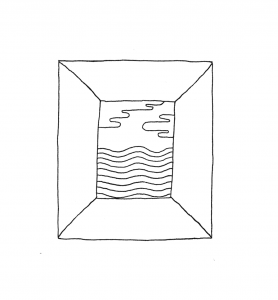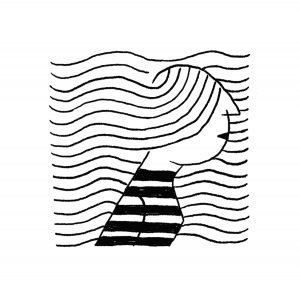Transmission from PLOT is a new monthly column related to CiTR and Discorder’s satellite location at Access Gallery, 222 East Georgia Street. Our residency continues until the beginning of February, during which time we will be creating and facilitating programming around artists, organizations and initiatives based in the immediate neighbourhoods of Chinatown and the Downtown Eastside.
For this first column, we have transcribed a discussion between Access Gallery’s Projects Coordinator Catherine de Montreuil, and two artists presenting in their current exhibition, Twenty-Three Days at Sea, Chapter 2: Rebecca Moss and Sikarnt Skoolisariyaporn. Both participated in the Twenty-Three Days at Sea Residency, which saw artists travel on cargo ships from Vancouver to Shanghai.
The following conversation is an excerpt that has been edited for clarity. The full audio will be broadcast on CiTR 101.9FM and citr.ca in October.
✶
Catherine de Montreuil: For those who didn’t hear about this last year, Rebecca was aboard the Hanjin Geneva last August and September, during which time Hanjin shipping corporation went bankrupt. Hundreds of ships were at sea at that time full of commodity goods, and as a result of the bankruptcy, the ships were not permitted to berth at any ports. Rebecca and the crew of Hanjin Geneva were stuck at sea for nearly three additional weeks while Hanjin sorted out their business.
What role do you feel you had as a passenger and as an artist, specifically, in the observation of this system [of commodity transport] that often remains invisible to a majority of people?
Rebecca Moss: I’m not that well versed in economics, so the way that I tell my story will be from the perspective of an artist, and hopefully can make these experiences in this strange world more accessible for people. But also in my position on the boat – obviously, I was in a position of privilege – I wasn’t worried about job security whereas, the captain and the crew were understandably very concerned. They didn’t want to be too vocal [or] too critical in the industry. Being an artist, you’re very free to express opinions on these things.
CDM: [This is] actually a question that I can direct to Sikarnt as well. I’m wondering if this experience has left you with any new questions about your role as an artist? In this residency, you’re there as this really direct observer to these systems of global capital, did you feel that it has affected your practice at this point?

Sikarnt Skoolisariyaporn: Well, first of all, I always feel I’m privileged as an artist, always educated from high school, and [being able to talk] about these kind of issues in the world that I’m actually not facing [in the same way] other people are. Being on the ship kind of took it to another level, in a way, because I was with these people that I would never have had a chance to know or be in contact with. You keep seeing each other everyday for almost a month, and you have to start getting familiar with each other. So, it’s a really new experience and a new way of relating [to] people.
CDM: What I’ve noticed in your work that I’ve seen so far, Sikarnt, you’ve taken to observing some of the darker qualities of the system. In the logbook you’ve produced for us, you talk about the grotesque life of goods under global trade. You describe the sea as a cemetery as well, so there’s definitely some dark undertones there. I was wondering if you could elaborate on that?
SS: Well, I guess the thing that really came to me when I was on the ship was mainly alienation in many, many ways. [I was] alienated from land, from time, from the connection between society. The sense that is made on land doesn’t make sense on a ship. We have our own clock, our own time, which felt like only us synchronized between each other and not the land. Also, alienation in a sense of the life of a seaman that facilitates this global capitalism, but is not really visible in the system whatsoever. I made the connection between these two, between [alienation] in space and time, and alienated labor in global capitalism.
The thing about containers that’s really fascinating is that they’re very generic. Even the person who’s super super close to it, has touched it, whatever, wouldn’t really have an idea of what’s inside. It could be human, it could be trash, anything. As an artist, that’s kind of exciting in a way.

CDM: Rebecca, you also talk about the life of commodity objects and these containers. When the Hanjin Geneva was at anchor, it seems that the goods had began to [expire].
RM: I think one thing that really struck me the longer that I was on the ship was that these anonymous containers began to feel a lot less anonymous, and the materials inside the containers began to exceed the boundaries of this anonymity and this mysteriousness. Chickpeas fell out and landed all over the deck. There were animal skins, and all of this brown seepage started trickling down the walls, all over the upper deck, and it was a smell that would really catch in your throat. I was thinking a lot about the materiality of the ship, about rust and the general filthiness of it and how old it felt, the physicality of the ship. I was really interested in this idea of this rich materiality as resistance towards this streamlined shipping industry, and that felt like a really interesting philosophical realization for myself with my work.
CDM: Totally. I find myself applying that to thinking about human bodies as being that resistance. That capitalism is meant to be so streamlined, but in the end, we are limited by the fact that we have physical bodies that wear down and there’s a certain limit. I often think about machines as having such a longer life, but in the end, they also start to wear down and fall apart and rust.
x
Twenty-Three Days at Sea, Chapter 2: Michael Drebert, Lili Huston-Herterich, Rebecca Moss, Sikarnt Skoolisariyaporn is on display at Access Gallery until October 28. More information at accessgallery.ca
Access Gallery gratefully acknowledges the support of the BC Government Collaborative Spaces Program and Measured Architecture for making PLOT possible. We also acknowledge the ongoing support of The Canada Council for the Arts, the Province of BC, the BC Arts Council and BC Gaming Commission, the City of Vancouver, and our committed donors, members, and volunteers.


